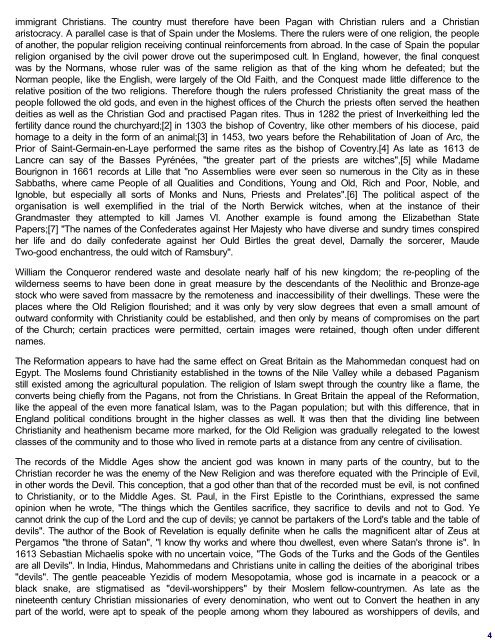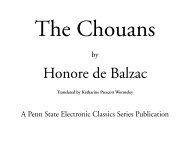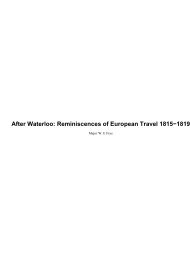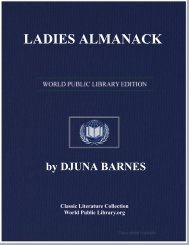THE GOD OF THE WITCHES - World eBook Library - World Public ...
THE GOD OF THE WITCHES - World eBook Library - World Public ...
THE GOD OF THE WITCHES - World eBook Library - World Public ...
Create successful ePaper yourself
Turn your PDF publications into a flip-book with our unique Google optimized e-Paper software.
immigrant Christians. The country must therefore have been Pagan with Christian rulers and a Christian<br />
aristocracy. A parallel case is that of Spain under the Moslems. There the rulers were of one religion, the people<br />
of another, the popular religion receiving continual reinforcements from abroad. In the case of Spain the popular<br />
religion organised by the civil power drove out the superimposed cult. In England, however, the final conquest<br />
was by the Normans, whose ruler was of the same religion as that of the king whom he defeated; but the<br />
Norman people, like the English, were largely of the Old Faith, and the Conquest made little difference to the<br />
relative position of the two religions. Therefore though the rulers professed Christianity the great mass of the<br />
people followed the old gods, and even in the highest offices of the Church the priests often served the heathen<br />
deities as well as the Christian God and practised Pagan rites. Thus in 1282 the priest of Inverkeithing led the<br />
fertility dance round the churchyard;[2] in 1303 the bishop of Coventry, like other members of his diocese, paid<br />
homage to a deity in the form of an animal;[3] in 1453, two years before the Rehabilitation of Joan of Arc, the<br />
Prior of Saint-Germain-en-Laye performed the same rites as the bishop of Coventry.[4] As late as 1613 de<br />
Lancre can say of the Basses Pyrénées, "the greater part of the priests are witches",[5] while Madame<br />
Bourignon in 1661 records at Lille that "no Assemblies were ever seen so numerous in the City as in these<br />
Sabbaths, where came People of all Qualities and Conditions, Young and Old, Rich and Poor, Noble, and<br />
Ignoble, but especially all sorts of Monks and Nuns, Priests and Prelates".[6] The political aspect of the<br />
organisation is well exemplified in the trial of the North Berwick witches, when at the instance of their<br />
Grandmaster they attempted to kill James VI. Another example is found among the Elizabethan State<br />
Papers;[7] "The names of the Confederates against Her Majesty who have diverse and sundry times conspired<br />
her life and do daily confederate against her Ould Birtles the great devel, Darnally the sorcerer, Maude<br />
Two-good enchantress, the ould witch of Ramsbury".<br />
William the Conqueror rendered waste and desolate nearly half of his new kingdom; the re-peopling of the<br />
wilderness seems to have been done in great measure by the descendants of the Neolithic and Bronze-age<br />
stock who were saved from massacre by the remoteness and inaccessibility of their dwellings. These were the<br />
places where the Old Religion flourished; and it was only by very slow degrees that even a small amount of<br />
outward conformity with Christianity could be established, and then only by means of compromises on the part<br />
of the Church; certain practices were permitted, certain images were retained, though often under different<br />
names.<br />
The Reformation appears to have had the same effect on Great Britain as the Mahommedan conquest had on<br />
Egypt. The Moslems found Christianity established in the towns of the Nile Valley while a debased Paganism<br />
still existed among the agricultural population. The religion of Islam swept through the country like a flame, the<br />
converts being chiefly from the Pagans, not from the Christians. In Great Britain the appeal of the Reformation,<br />
like the appeal of the even more fanatical Islam, was to the Pagan population; but with this difference, that in<br />
England political conditions brought in the higher classes as well. It was then that the dividing line between<br />
Christianity and heathenism became more marked, for the Old Religion was gradually relegated to the lowest<br />
classes of the community and to those who lived in remote parts at a distance from any centre of civilisation.<br />
The records of the Middle Ages show the ancient god was known in many parts of the country, but to the<br />
Christian recorder he was the enemy of the New Religion and was therefore equated with the Principle of Evil,<br />
in other words the Devil. This conception, that a god other than that of the recorded must be evil, is not confined<br />
to Christianity, or to the Middle Ages. St. Paul, in the First Epistle to the Corinthians, expressed the same<br />
opinion when he wrote, "The things which the Gentiles sacrifice, they sacrifice to devils and not to God. Ye<br />
cannot drink the cup of the Lord and the cup of devils; ye cannot be partakers of the Lord's table and the table of<br />
devils". The author of the Book of Revelation is equally definite when he calls the magnificent altar of Zeus at<br />
Pergamos "the throne of Satan", "I know thy works and where thou dwellest, even where Satan's throne is". In<br />
1613 Sebastian Michaelis spoke with no uncertain voice, "The Gods of the Turks and the Gods of the Gentiles<br />
are all Devils". In India, Hindus, Mahommedans and Christians unite in calling the deities of the aboriginal tribes<br />
"devils". The gentle peaceable Yezidis of modern Mesopotamia, whose god is incarnate in a peacock or a<br />
black snake, are stigmatised as "devil-worshippers" by their Moslem fellow-countrymen. As late as the<br />
nineteenth century Christian missionaries of every denomination, who went out to Convert the heathen in any<br />
part of the world, were apt to speak of the people among whom they laboured as worshippers of devils, and<br />
4















